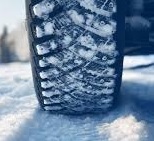
Apart from the driver, the second most important component on a vehicle is its tires.
You can go out of your way to get a vehicle with the best handling and the most intelligent all-wheel-drive system on the market, but if you can’t put the power down with proper traction, all that goes to waste.
Note: Tire prices can vary depending on the size of the tire.
Fact: Studs only provide additional grip on clear ice.
Studs themselves are small, sharp metal protrusions installed into the tread of a tire. (Tungsten carbide, an extremely hard metal).
Because they get between the rubber and whatever surface you’re driving across, they need to be able to poke into that surface and momentarily stick there, resisting lateral forces, to provide grip.
Picture other winter surfaces: in packed, loose, or deep snow, the studs will definitely penetrate, but they won’t find the resistance necessary to actually add grip. In slushy or wet conditions or on bare pavement, the tire needs to come into contact with the road surface in order to find traction—and the metal studs actually get in the way of that.
Studs aren’t the only things that wear when they’re driven on bare pavement. The road surface itself is also torn to pieces.
By damaging pavement so significantly, studs create a significant amount of pollution, throwing microscopic asphalt and concrete particles into the air.
You can’t always dictate the surface you drive on; you need a tire that works across the hazardous conditions you face in winter months, and that is not studs.
This winter, you will drive in extreme cold, you will drive in snow, you will encounter bare plowed highways.
Winter Driving is defined by its unpredictability.
There is a device designed to deal with it all:
THE MODERN STUD LESS WINTER TIRE

So, studs help on bare ice only, do nothing for you in snow, and make you less safe in other conditions.
In Ontario, bare ice between zero- and 32-degrees accounts for less than two percent of vehicle miles traveled.
Ontario
Studded tires can be used between October 1 and April 30 for vehicles with an ownership address in Northern Ontario, as defined by the Territorial Districts of Algoma, Cochrane, Kenora, Manitoulin, Nipissing, Parry Sound, Rainy River, Sudbury, Thunder Bay, and Temiskaming.






